

Tasmania pre- federation. SA pre- federation. WA pre- federation. Victoria pre- federation. NSW pre- federation. Why federate - The reasons behind the movement. Even though they shared a British heritage, for a long time the six colonies saw themselves as separate from each other.
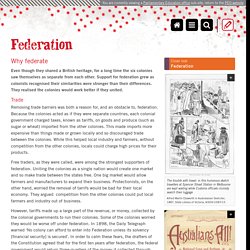
Support for federation grew as colonists recognised their similarities were stronger than their differences. They realised the colonies would work better if they united. Trade Removing trade barriers was both a reason for, and an obstacle to, federation. An article on the reasons behind federation for each of the states. This article was contributed by Scott Bennett of the Parliamentary Library, Canberra.
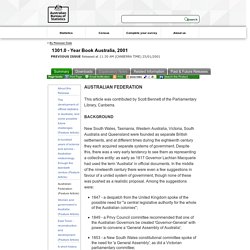
New South Wales, Tasmania, Western Australia, Victoria, South Australia and Queensland were founded as separate British settlements, and at different times during the eighteenth century they each acquired separate systems of government. Despite this, there was a very early tendency to see them as representing a collective entity: as early as 1817 Governor Lachlan Macquarie had used the term 'Australia' in official documents.
Federation – The Referendums 1898–1900. Federation fast facts. Background information.

1890 to 1900 - Towards Federation. Turbulent Times: New South Wales in the 1890s Strike Meeting at Queens Square in Macquarie Street, Sydney, 1890s The 1890s were a testing time throughout the eastern Australian colonies.
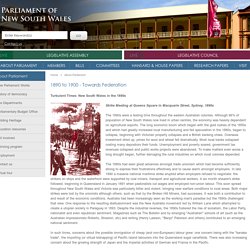
Although 66% of population of New South Wales now lived in urban centres, the economy was heavily dependent on agricultural exports. The long economic boom which began with the gold rushes of the 1850s and which had greatly increased local manufacturing and fed speculation in the 1880s, began to collapse, beginning with Victorian property collapses and a British banking crises. Overseas investment dried up; prices for wool and wheat fell dramatically.
The 1880s had seen great advances amongst trade unionism which had become sufficiently strong to express their frustrations effectively and to cause alarm amongst employers. The Federation Conventions. The path to federation. Federation. The Federation Kiosk, Centennial Park, Sydney at the Proclamation of Federation, 1 January 1901.

Image courtesy of the. It's hard to imagine in contemporary Australia, but prior to Federation each of the Australian colonies was more like its own country with customs houses, railway gauges and even their own military. It was neither natural nor inevitable that Australia would be federated, in fact it wasn't even a very popular idea. Only through the dedication and hard work of a small group of people did the colonies eventually come together to form a nation.
Colonial politicians like Alfred Deakin, Henry Parkes and Edmund Barton waged a long campaign to turn the six colonies of 3.7 million people into a country in its own right. 1860s Colonial life. Growing up in the early 1900s. Australia's migration history timeline. The Founding of Australia.

By Capt. Arthur Phillip R.N. Sydney Cove, Jan. 26th 1788, Algernon Talmadge R.A, 1937, Courtesy State Library of New South Wales The First Fleet of 11 ships, each one no larger than a Manly ferry, left Portsmouth in 1787 with more than 1480 men, women and children onboard. Although most were British, there were also African, American and French convicts. La Boussole and l’Astrolabe in the Sandwich Islands, c.1786. On 26 January two French frigates of the Lapérouse expedition sailed into Botany Bay as the British were relocating to Sydney Cove in Port Jackson. Discover the 1787 Draught Instructions for Governor Phillip that empowered Captain Arthur Phillip to establish a British Colony at Botany Bay, grant land and issue regulations to the Colony from 1788.
A Brief Aboriginal History. “The very ink with which all history is written is merely fluid prejudice.”

Mark Twain Since the European invasion of Australia in 1788, the Aboriginal people have been oppressed into a world unnatural to their existence for thousands of years. First came the influx of the strangers who carried with them diseases, which decimated the immediate population of the Sydney tribes. It is estimated that over 750,000 Aboriginal people inhabited the island continent in 1788.
The colonists were led to believe that the land was terra nullius (‘no one’s land’), which Lt James Cook declared Australia to be in 1770 during his voyage around the coast of Australia. “… they were so ignorant they thought there was only one race on the earth and that was the white race. It would not be an exaggeration to claim that the Island continent was owned by over 400 different nations at the time of this claim by Cook.
The First Fleet. THE FOUNDERS OF A NATIONAUSTRALIA’S FIRST FLEET – 1788by Cathy Dunn Between 1788 and 1850 the English sent over 162,000 convicts to Australia in 806 ships.

The first eleven of these ships are today known as the First Fleet and contained the convicts and marines that are now acknowledged as the Founders of Australia. This is their story. ~ GOLD ~ Australian gold rush. The 1850s gold rush attracted many Chinese people to Australia in search of a fortune.
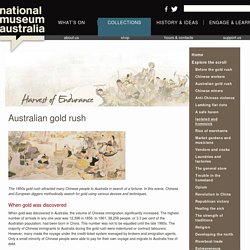
In this scene, Chinese and European diggers methodically search for gold using various devices and techniques. When gold was discovered. Australian Gold. The community, owners and staff of the Original Gold Rush Colony in Mogo (NSW South Coast Australia) have a wealth of information to share.
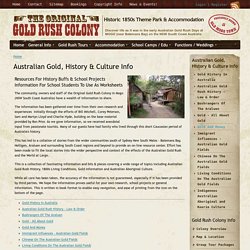
The information has been gathered over time from their own research and experiences initially through the efforts of Bill Mitchell, Corey Peterson, Sam and Martyn Lloyd and Charlie Hyde, building on the base material provided by Ron Prior. As we gave information, so we received anecdotal input from passionate tourists. Many of our guests have had family who lived through this short Caucasian period of Australia's history. This has led to a collation of stories from the wider communities south of Sydney New South Wales - Batemans Bay, Nelligen, Araluen and surrounding South Coast regions and beyond to provide an on-line resource center. The Australian gold rush. JCF Johnson, A Game of Euchre, col. wood engraving, Australasian Sketcher Supplement [Melbourne], 25 December, 1876.
Image courtesy of the : nla.pic-an8927787. The gold rushes of the nineteenth century and the lives of those who worked the goldfields - known as '' - are etched into our national . There is no doubt that the gold rushes had a huge effect on the Australian economy and our development as a nation. It is also true to say that those heady times had a profound impact on the national psyche. The camaraderie and '' that developed between diggers on the goldfields is still integral to how we - and others - perceive ourselves as Australians.
Indeed, mateship and defiance of authority have been central to the way our history has been told. Even today, nothing evokes more widespread national pride than groups of irreverent Aussie 'blokes' beating the English at cricket, or any other sport for that matter! Ancient Australian History. At the time of colonisation of Australia, Great Britain was in need of new land to place its convicts. After early sightings of Australia by James Cook, it was decided that Australia would become a new British colony where convicts would be sent and used for labour in establishing the new colony. In 1788, the first fleet of ships landed in Botany Bay and so began the colonisation of Australia. European Exploration (1400-1788) - Before the English officially landed on Botany Bay in 1788, tthere were many expeditions to find the Great Unknown South Land, that was believed to be full of gold.
The first European to discover was thought to have been Willem Jansz, a Dutchman who sailed along part of the Gulf of Carpentaria in 1606 and landed on Australian soil. First Landing - In August 1786, the British government decided to start a convict settlement in New South Wales. The changing face of early Australia. Millions of people from all over the world have made Australia their home. Their lives and experiences have influenced all aspects of Australian life. In particular, the new arrivals, or immigrants, have contributed significantly to the working life of Australia—from , the , the sugar cane fields, and construction sites through and luggers to factories, , cafés and many other business. A lady holding a small child [Quarantine Station], Tom Gray Collection, 3. Image courtesy of . Eventually, the arrival of people from diverse societies created a cultural diversity that is now an integral part of Australian society and identity.
Childhood Experiences in Australia 1788-1901. Download lecture: Childhood Experiences in Australia 1788-1901Download pdf of slides This lecture presents an archaeological investigation of European childhood in Australia spanning the years 1788 – 1901. Applying the sociological theory of interpretive reproduction (Corsaro 2005), which posits that childhood is a social construction resulting from collective actions of children with adults and each other, the research focuses on revealing children’s creativity and agency as reflected in the material culture of childhood. Margaretha Vlahos is an archaeology postgraduate student from the University of Queensland. Indigenous Australians.
First Australians.